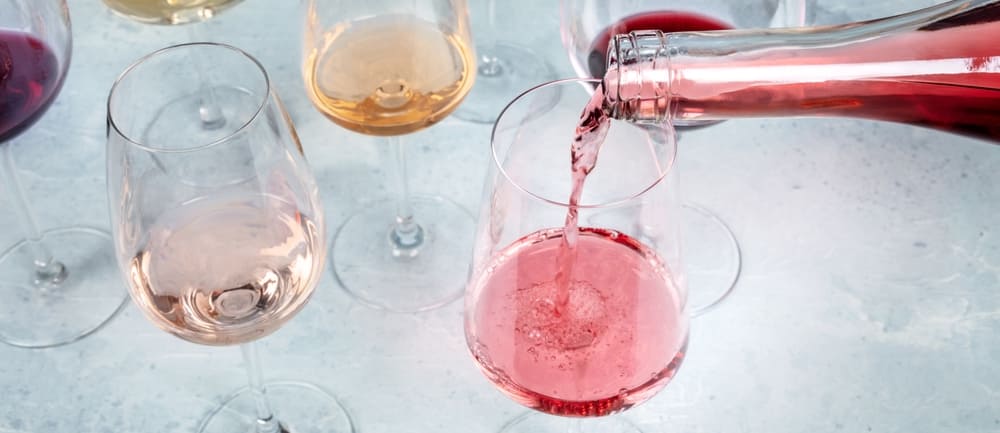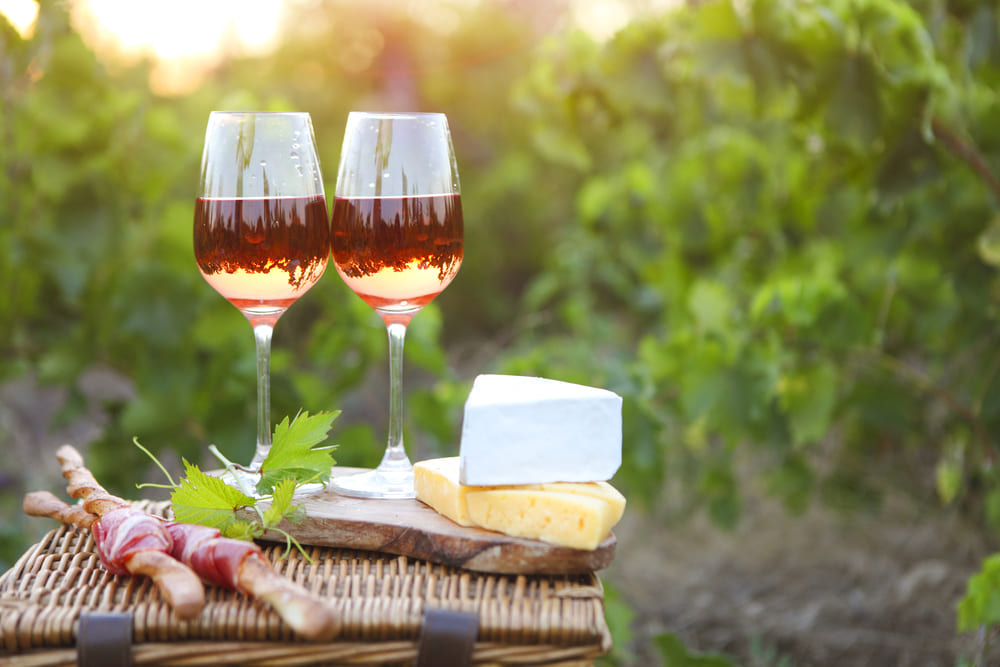Rosé is a wine everyone can enjoy, whether you’re a wine aficionado or just starting to dip your toes into the world of wine. It comes in various flavors and sweetness levels to perfectly complement your taste preferences. Plus, it’s meant to be enjoyed with light warm-weather dishes, cozy cold-weather dishes, and even on its own. When it comes to Rosé, the options are endless.
Let’s look at what Rosé wine is, how it’s made, and what dishes different Rosés pair best with. Plus, check out our Rosé wine sweetness chart below to help you compare different types of rosé.
What Is a Rosé Wine?
Unless you’re an expert, you might be asking, “What even is Rosé wine?” Rosé is one of the world’s oldest styles of wine, originating in Southern France in the 6th century BC. It comes in various types, each featuring distinct aromas and flavor profiles to fit your preference.
This type of wine ranges from sweet to dry based on the grapes and methods it’s made with. For example, lighter Rosés resemble white wines with fresh, fruity, and floral notes while darker Rosés more closely resemble full-bodied red wines with red berry or earthy notes.

How Is Rosé Wine Made?
Although Rosé is made with the same grapes used to make red wine, the production processes are slightly different. For Red wine production, the grapes are crushed and then soaked in the skins for longer periods, the soaking period is only 2-20 hours for Rosé wine production. This produces a lighter, pinker wine rather than a darker red wine.
Types of Rosé Wine Grapes
Grenache, Syrah, Cabernet Sauvignon, Tempranillo, Sangiovese, Malbec, Mourvedre, Carignan, Zinfandel, Cinsault, and Pinot Noir grapes are all commonly used to make Rosé wine. While the same grapes are used to make red wine, the production methods used to make Rosé wine produce a lighter wine.
Rosé Winemaking Methods
Maceration
Maceration involves pressing the grapes and letting them sit in the skins for 2-20 hours. The skins are then removed to maintain the signature pink color of Rosé. The longer the grapes sit in the skins, the darker the wine will be.
Saignée
Saignée involves draining some of the red wine juice produced when the grapes are crushed. The amount of juice drained determines what shade of pink the Rosé will be.
Direct Press
Direct press drains the juice produced from pressing the grapes immediately. This immediate intervention produces light pink Rosés with crisper, fruitier flavors.
Blending
Blending is typically done in Champagne to create their Rosé Champagne. They will combine the juice from Pinot Noir, Pinot Meunier and Chardonnay to create a blend.

Is Rosé Wine Sweet?
The sweetness of a Rosé wine depends on many factors. This can include the grapes, production method, and winemaker preferences. They can range from very sweet wine to bone dry wine.
Rosé Wine Sweetness Chart
Here’s a closer look at the sweetness levels of Rosé wine, including some examples for each type:
| Sweetness | Type of Rosé |
|---|---|
| Bone Dry | Tavel, Grenache |
| Semi-Dry | Syrah, Cabernet Sauvignon |
| Dry | Pinot Noir, Tempranillo |
| Off-Dry | Sangiovese |
| Semi-Sweet | Sparkling Rosé, Montepulciano |
| Sweet | White Merlot, White Zinfandel |
| Lusciously Sweet | Pink Moscato |
How to Drink Rosé
Properly storing and serving Rosé directly impacts the quality and enjoyment of the wine. Here are some pro tips you should follow to enhance your wine-drinking experience:
- Store the Rosé in a refrigerator or wine cooler for 2-4 hours at 55° Fahrenheit.
- Set the Rosé out 15-30 minutes before serving it.
- Serve the Rosé between 48° and 53° Fahrenheit to enhance its fruity flavors and tannins. Keep serving temperatures in mind; lighter Rosés should be served more chilled, while darker Rosés should be served less chilled.
Ideal Rosé Food Pairings
Drinking Rosé on its own is one thing, but drinking it alongside a dish is another entirely. Since Rosé wines vary so much in their sweetness and flavor profiles, it’s important to choose the right one to serve with dinner. The last thing you want is for a poor pairing to make you a Rosé hater.

Here are some popular seasonal rosé wine pairing ideas to try at your next family dinner or girls’ night in:
Spring Pairings
Provence Rosé pairs well with fresh spring salads full of mixed greens, berries, and cheese. If you’re a seafood fan, try pairing a slightly chilled glass of Rosé with lemon-drizzled grilled shrimp. The fresh, crisp flavors of the Rosé bring out the best in these signature spring dishes.
Summer Pairings
Grilled salmon and mango salsa couple perfectly with a chilled Rosé from the Loire Valley. The acidity of the Rosé complements the smoky salmon and sweet salsa.
Fall Pairings
Rosé isn’t just for spring and summer; it also pairs well with cozy fall dishes like butternut squash risotto. The red berry and spice flavors of darker Rosés balance the creaminess of the risotto.
Winter Pairings
Who doesn’t love a charcuterie board, even in the wintertime? Pair your favorite meats, cheeses, and jams with a bottle of brut Rosé to balance out the rich flavor combinations.

Our Best Rosé Wine Picks to Try
With so many options to choose from, selecting the right Rosé can be overwhelming. But don’t stress; we’re here to help.
- 🍷 Start your Rosé journey with a classic French bottle, like our Violette de Mireval Rosé. This pale pink bottle features citrus and exotic fruit flavors with a spicy undertone. It pairs best with salads, fresh seafood, and Asian dishes.
- 🍷 Our Amore Organic Rosé features fresh notes of apple, ginger, and sweet florals with a hint of spice. This Italian wine is fruit-forward with high levels of acidity.
- 🍷 Looking for something sweet to enjoy with your dessert? Try our Tussock Jumper Moscato Rosé. This Spanish Rosé is rich with sweet, fruity flavors that pair well with cakes and chocolate.
Shop our Rosé wine collection today to find the perfect bottle for your next night in or special occasion.






Leave A Comment